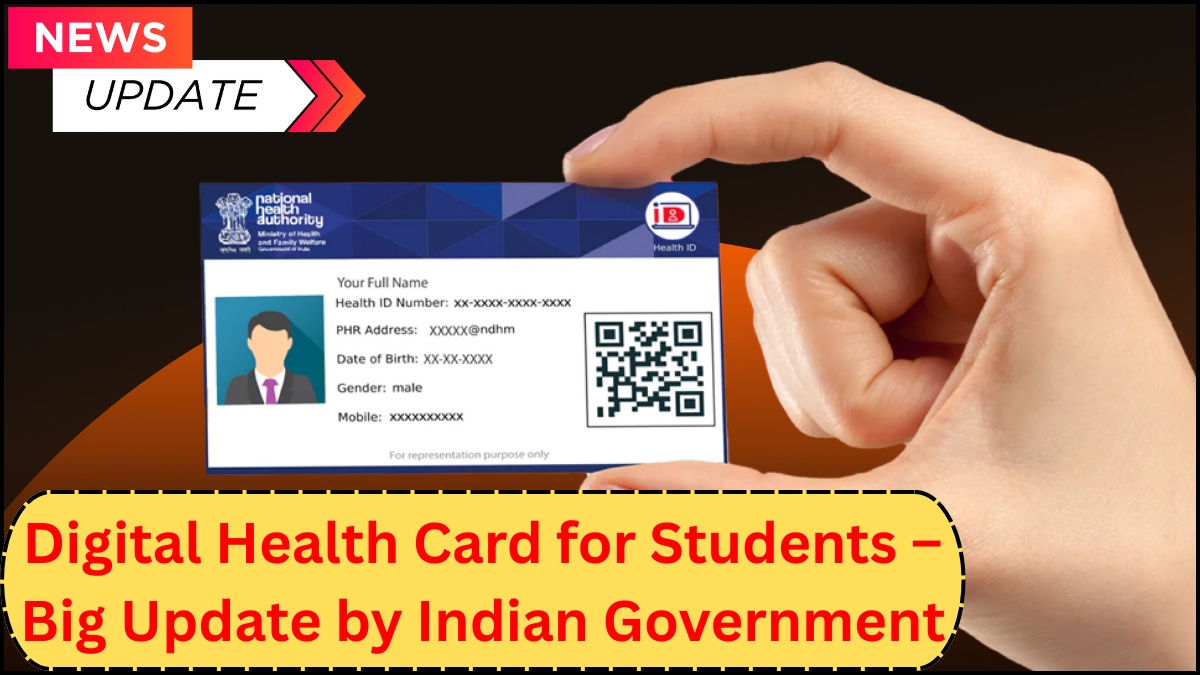In a groundbreaking move to digitize and streamline healthcare access for young citizens, the Indian government has introduced the Digital Health Card for students. This initiative is part of the larger Ayushman Bharat Digital Mission (ABDM), aimed at building a robust digital health ecosystem across the country. With students at the core of this rollout, the goal is to provide every child with a unique health ID in India, which securely stores their medical records, making them accessible across healthcare providers.
Let’s break down what this development means, why it matters, and how it will shape the future of student healthcare in India.

What Is a Digital Health Card for Students?
A Digital Health Card for students is an electronic health record that contains a student’s personal health data, such as vaccination history, medical check-up records, allergies, past illnesses, and any prescribed treatments. This health ID is unique to each student and can be accessed via the National Health Authority’s (NHA) platform under the ABDM framework.
Instead of relying on paper records stored at school clinics or with parents, this card enables secure, digital tracking of a child’s health journey from early school years into adulthood.
Key Features and Benefits of the Digital Health Card
1.Centralized Health Information
Each student receives a digital health ID that stores their complete medical history in a cloud-based system. This ensures that authorized doctors and school medical staff can access relevant data instantly during emergencies or routine check-ups.
2.Seamless Access to Healthcare
Students changing schools or cities often face gaps in healthcare records. With a portable health ID in India, continuity of care becomes possible. Whether it’s a doctor in Delhi or a pediatrician in Chennai, access to accurate medical data ensures better diagnosis and treatment.
3.Early Detection of Health Issues
With periodic screenings integrated into the system, schools can identify early signs of health concerns such as anemia, malnutrition, vision problems, or mental health issues. Real-time alerts to parents and guardians allow for quicker medical intervention.
4.Strengthening Preventive Healthcare
The card helps track immunizations, nutrition plans, and wellness programs systematically. It’s particularly useful during nationwide campaigns like pulse polio, COVID-19 vaccinations, or deworming drives.
Implementation Plan: How the Rollout Is Being Handled
The Ministry of Education and the Ministry of Health and Family Welfare are collaborating to integrate digital health infrastructure within schools. Initially, the scheme is being rolled out in government and government-aided schools, with private institutions to be included in the later phases.
Health workers will assist schools in collecting and uploading basic health data for each child. Parents will be guided on how to access their child’s health ID and update it through the official portals or mobile apps.
Addressing Privacy and Data Security Concerns
One of the biggest priorities for the government is ensuring that sensitive student health data is protected. The health ID system follows end-to-end encryption and allows students or guardians to control access. No data can be viewed or shared without explicit consent, aligning with global standards in digital health record protection.
Long-Term Impact on India’s Healthcare Ecosystem
The Digital Health Card for students is not a standalone tool—it’s a foundational step toward a lifelong digital health journey. Children who start with digital records today will enter adulthood with a well-documented medical history, reducing diagnostic errors, avoiding redundant tests, and improving treatment outcomes.
Moreover, aggregated and anonymized data will help the government shape better public health policies. For instance, identifying clusters of poor nutrition in certain regions can prompt targeted nutrition programs.
How to Apply for a Student Digital Health Card
Visit the official Ayushman Bharat Digital Mission portal or use the ABHA mobile app.
Submit Aadhaar and school enrollment details for verification.
The student will be issued a unique health ID number and QR code.
This ID can then be linked with various healthcare providers and school systems.
Schools will also play an active role in enrolling students, especially in rural and semi-urban areas where digital access may be limited.
Frequently Asked Questions (FAQ)
Q1. What is the purpose of a Digital Health Card for students?
A: The card provides a centralized, secure way to store and access a student’s medical history, enabling better health management and preventive care.
Q2. Is the digital health ID mandatory for students?
A: Currently, it is voluntary, but the government is encouraging participation to improve long-term healthcare outcomes.
Q3. Can parents control who sees their child’s health data?
A: Yes. The system is consent-based. No data can be accessed without the guardian’s or student’s permission.
Q4. What kind of health data will be stored?
A: Information such as vaccinations, chronic conditions, doctor visits, prescriptions, and fitness assessments can be stored.
Q5. Will this replace school medical records?
A: It will complement and eventually digitize existing school health records, making them easier to access and manage.
click here to learn more